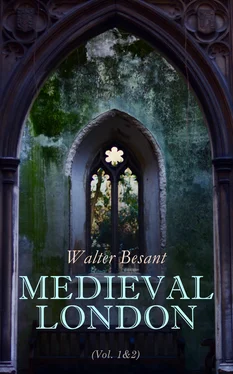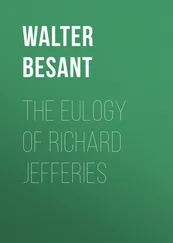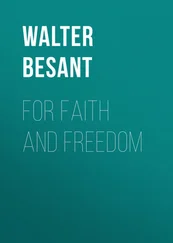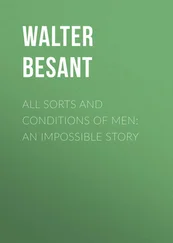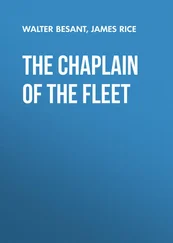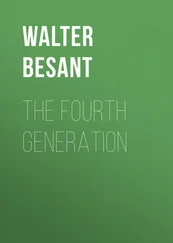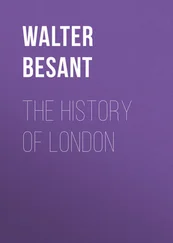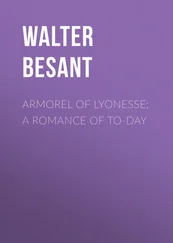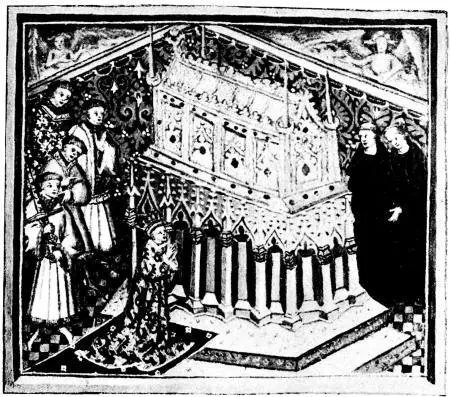
HENRY VI. AT THE SHRINE OF ST. EDMUND
From MS. in British Museum. Harl. 2278.
Next year Henry was taken over to Paris, and there also solemnly crowned, with no doubt another Coronation banquet. In the same year there was a small and unimportant tumult which shows the lingering of Lollardy. The leader who called himself Jack Sharpe wanted to have a rising in London in order to take away the temporalities of the Church. The Chronicle of London says that his name was William Maundeville, some time a weaver of Abingdon. He chose his time when the King and most of the lords were away in France, when, with his friends, he spread abroad bills and placards in every town. Nothing came of it except to himself and his party, for he and some of his friends were hanged, drawn, and quartered, and their heads set upon London Bridge. And, the same year, there was one Russell, a craftsman of free and independent thought, who purposed to create an entirely new House of Lords after his own ideas. He, a Reformer before his age, was hanged, drawn, and quartered. In the same year it is casually mentioned “that Pucylle was brent at Rone and that was upon Corpus Christi Even.”
In January 1432 the King returned to England, and on St. Valentine’s Day (Sharpe says 20th February: Gregory says Valentine’s Day) he was received by the City, the Mayor, Aldermen, and Sheriffs, with an immense following of citizens, who rode out as far as Blackheath to meet him. They presented him with the following address:—
“Sovereign Lord as welcome be ye to your Roiaulme of Englond, and in especial to your notable Cite London, otherwise called your Chambre, as ever was Christen Prince to place or people, and of the good and gracioux achevying of your Coronne of Fraunce, we thank hertlich our Lord Almighty which of His endless mercy sende you grace in joye and prosperite on us and all your other people long for to regnew.”
The King receiving this address rode on to Deptford, where he was met by a whole regiment of clergy all in their robes, with monks chanting psalms of praise. Thence into London where a noble reception awaited him. The description which follows is also taken from Gregory’s Chronicle.
“At the south end of London Bridge was erected a tower: and in the tower stood a giant holding a sword and saying solemnly Inimicos ejus induam confusione . On each side of the giant was an antelope, one with the arms of England and one with that of France. At the drawbridge was another tower with three crowned empresses namely, Nature, Grace, and Fortune who gave the young king gifts. On the right hand of the Empresses stood seven fair maidens in white powdered with stars of gold, who gave the king seven gifts of the Holy Spirit in the likeness of seven white doves. On the left side were seven maidens in white powdered with stars of gold, who gave the king seven gifts of worship, and the maydens sang an hevynly songe unto the kynge of praysynge and of hys victorye and welle comynge home.”
At the Conduit of Cornhill there was a tabernacle in which sat a King in royal apparel: with him the Lady of Mercy, the Lady of Truth, and the Lady of Cleanness, “hem embracing with Reson.” Before the King two Judges of great worthiness with eight serjeants-at-law with this scripture—
“Honowre of kyngys in every mannys syght
Of comyn curtosie, lovythe, equyte, and ryghte.”
At the Great Conduit there was a royal sight like unto Paradise. There were virgins drawing water and wine of joy and of pleasure and comfort, the which are to every man’s comfort and health. These maidens were named Mercy, Grace, and Pity. In this Paradise stood two old men “like heveynly folk.” They were named Enoch and Eli, and they saluted the King with words of grace and virtue.
“And soo rode he forthe unto the Crosse in Cheppe. There stood a royalle castelle of jasper grene, and there yn ij grene treys stondyng uppe ryght, showyng the ryght tytyllys of the Kyng of Inglond and of Fraunce, convaying from Synt Edwarde and Synt Lowys be kyngys unto the tyme of Kyng Harry the vj every kyng stondynge whythe hys cote armowre, sum lyberdys, and sum flourdelysse; and on that othyr syde was made the Jesse of owre Lorde ascendyng uppewards from Davyd unto Jesu. And so rode he forthe unto the Lytylle Condyte. And there was a ryalle mageste of the Trynyte, fulle of angelys syngyng hevynly songys, blessynge ande halowynge the kyngys whythe thes resonys in Latyn wrytyn; Angelis suis mandavit de te ut custodiant te , etc. Longitudinem dierum replebo in eum et ostendam illi salutare meum. And thenne vente he forthe unto Poulys, and there he was ressayvyd whythe bysvhoppys and prelatys whythe dene and the quere, and whythe devoute songe, as hyt longythe to a kynge. Ande so he offerryd there and thankyd God of hys goode speede and of hys welfare. And thenne he rode to Westemyster, and there he restyd hym: and on the nexte day followynge the mayre and the aldyrmen whythe a certayne comeners that were worthy men, and they presentyde the kynge whythe an hampyr of sylvyr and gylte, whythe a M l. there yn of nobellys, etc.”
The next great Riding was the reception of Margaret of Anjou when she came over to be married in the year 1445, when the same “properties,” castle, tower, and other devices, were brought out to greet her.
The disastrous wars in France, the lavish expenditure which produced nothing but defeat, the unsettled condition of the Low Countries with which the greatest part of the London foreign trade had been carried on, a succession of bad harvests, with other causes, affected the prosperity of the City as well as smaller towns very sensibly. When the Parliament of 1433 voted a fifteenth and a tenth it assigned £4000 to the relief of poor towns. Of this sum £76: 15: 6¼ was assigned to eighteen wards of London.
In 1447 a petition was presented to Parliament by four priests of the City, viz. William Litchfield, Allhallows the Great: Gilbert, St. Andrew’s Holborn; John Cote, St. Peter’s Cornhill: and John Neil, St. Thomas Acons Hospital, and St. Peter Colechurch; praying for permission to set up schools of grammar in their respective parishes. They base their request on the small and insufficient number of schools in London compared with the great number that had existed in former days. What schools were they? FitzStephen mentions three in the time of Henry II. What grammar schools were founded between 1150 and 1450? Every monastery it is said had its school. Certainly the novices and the wards of the Abbot were under instruction: their place was assigned to them in the Cloisters and there were rules as to their supervision. But the sons of the citizens were not admitted to these schools. The King replied that the schools might be established or provided, subject to the approval of the Archbishop.
We have now arrived at a strange and not wholly intelligible event, the rising of the Kentish men and their occupation of London.
The most important of these rebellions, known as that of Jack Cade, was one among many which showed the temper of the people. The reverses in France, where all that Henry V. had won was lost, never to be recovered; the exactions and taxations; the many cases in which persons were accused of treason and thrown into prison in order that others might obtain their lands; created a widespread discontent, which, in these risings, became the wrath which seizes on the sword and demands the ordeal of civil war. There were at least three other leaders in Kentish risings, one called Blue Beard, another named William Parminter and a third named John Smyth. In Wiltshire the Bishop of Salisbury was dragged from the altar and brutally murdered; and the insurgents in that county were reckoned at 10,000 men.
Читать дальше
